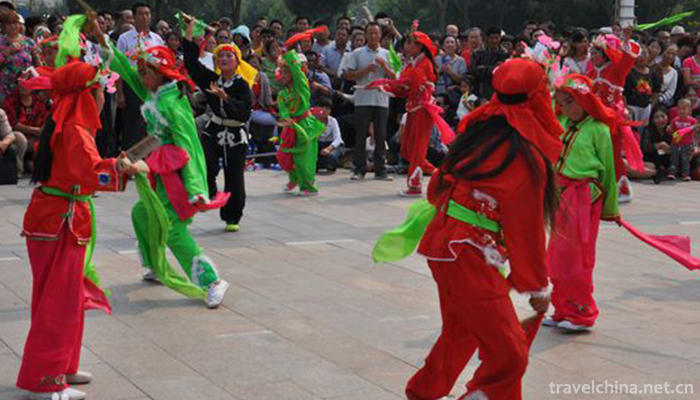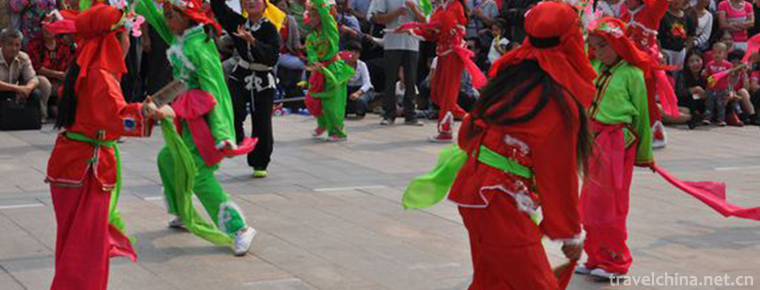Cangzhou Lazi
Cangzhou Lazi
Cangzhou Laozi is a traditional folk dance with strong local characteristics in the central area of Hebei Province. Laozi is one of the representative folk dances in Hebei Province. It spreads in Cangzhou, especially in Cangxian and Nanpi counties. It has a history of more than 150 years. In winter, when the farmers are free, they rehearse and perform around the fifteenth day of the first lunar month to show the joy of celebrating the harvest and leaving the old to welcome the new.
In June 2008, Cangzhou Luozi declared by Nanpi County of Hebei Province was listed in the second batch of national intangible cultural heritage list with the approval of the State Council.
Heritage serial number: 643 III-46.
historical origin
According to Cangxian County Chronicle of Hebei Province, Laozi is a small farm in the big Yangko, which originated in Jiaqing and Daoguang years of the Qing Dynasty (1796-1821). Traditionally, women walk on Cun stilts (also known as Cun stilts), hold flower fans or bamboo boards, and men beat bully whips with their hands. Laozi's dance is characterized by fewer fans and flowers, more dancing postures and shapes, paying attention to the beauty of curves and paying attention to charm. The style of fan dancing is natural and unrestrained. The action range of board dancing is large, the rhythm changes a lot, and it is very bright.
artistic characteristics
Form of performance
Wen Laozi mainly composed of songs and dances, often performing several folk songs together. In the equipments of props, whips, boards and fans are interlaced with each other, and only fans are used for performances. The local people call it Wen Laozi or Xiao Fengyuan. After the Revolution of 1911, women's foot binding began to be liberated, and men dressed as women began to be eliminated. As a result, the movements of Laozi dance have been enriched and developed accordingly. On the basis of Wen Laozi, some movements and techniques in opera have been properly absorbed, which blend with the movements of Laozi dance, adding a warm, robust, cheerful and bold atmosphere, strengthening the elements of dance and martial arts, and reducing the composition of songs accordingly. On props, only whip and board are used, no fan is used. Locals call it Wu Luozi or Feng Yangge.
Art schools
The first group was Yang Fa-tzu, who performed only four whips at the earliest stage, and then changed to four whips and four boards. Later, the performances of fans were added, which were divided into five whips, three boards and two fans. In the process of handing down from generation to generation, each generation of artists has made different degrees of improvement and development of Yang Fa Laozi, making it increasingly perfect, leaving valuable folk art heritage for future generations.
The other is the cap school. At first there was only a martial field accompaniment, then a literary field accompaniment was added. The Hat Family did not perform with fans, but only with two whips and eight boards. Cangzhou people are fond of practicing martial arts and have been influenced by martial arts for a long time. Therefore, it is also evidently reflected in the dance of falling sons. The basic movements of male performers in Fall Zi Dance mainly come from the single-knife style in Wushu. For example, it is the most basic action of male actors. "Xubu" is a triangular route, which is called "triangular riveting" by the old artists. That is to say, the pace is steady, just like riveting on the ground. The actresses'movements such as "drawing board", "winding head board", "pedaling" and "empty step" are also close to those of Wushu.
Traditional programs
The traditional programs of Laozi mostly express the hard life of the working people in the old society, as well as love stories and people's longing for freedom, happiness and a better life, such as Jasmine Flower, Kite Flying, Sighing Lover, Embroidered Handkerchief, Nigu Sifan, etc. Among them, "Rongli Flower" and "Kite Flying" are processed and sorted out to be more beautiful and moving, and become the lasting reserved programs in the dance arena.
Inheritance status
Zhou Shutang, the late famous folk dancer, made outstanding contributions in inheriting and developing Cangzhou Laozi. Zhou Shutang studied art in "Laozi Fang" since childhood. After more than forty years of training, he has become an art genre of Laozi Dance. His dancing rhythm is characterized by a prominent depiction of the female "three bends" dance posture: the head is crooked, the waist is twisted, the legs are curved, the lines are beautiful, the charm is strong, making people feel elegant, beautiful and dignified. In terms of dance steps, it absorbs the advantages of Chinese classical dance and brotherly national dance. Zhou Shutang believes that if folk dance does not develop and innovate, there will be no vitality. In order to develop the slab dance and fan dance in Laozi dance, he recorded many dance vocabulary and dance movement rhythm from folk dances of various nationalities. After some analysis and research, he melted many dance language into the dance, and then processed more than 20 sets of fan flower and slab dance action combinations. These magnificent and varied movements have enhanced the expressive force of Laozi dance and developed the traditional art of Laozi dance.


-
1.Qiangcheng Tourist Area Beichuan
Mianyang Beichuan Qiang Town Tourist Area is located in Beichuan Qiang Autonomous County, northwest of Sichuan Basin. It consists of Beichuan Earthquake Relics Area, Beichuan New County Town
Time 2018-12-12 -
2.Shibing Karst
Karst is karst. It is the general name of the geological function of water in dissolving rock (carbonate rock, gypsum, rock salt, etc.) mainly by chemical dissolution
Time 2019-02-08 -
3.Tianta Lake Scenic Area
Tianta Lake Scenic Spot is located in the south of Tianjin City, close to the water park scenic spot, is the main attraction of Tianjin Radio and Television Tower. Tianta is the Tianjin Radio and Tele
Time 2019-02-21 -
4.Tomb of Zhang Qian
Zhang Qian's tomb was the tomb of Zhang Qian, an outstanding diplomat, explorer and pioneer of the Silk Road in the Western Han Dynasty. In the third year of Emperor Yuanding of Han Dynasty (114 years
Time 2019-03-16 -
5.Qingyang Opera
During Jiajing period of Ming Dynasty, Yiyang Tune of Jiangxi flowed into Qingyang County of Chizhou Prefecture in Southern Anhui Province. It was combined with local language, folk opera (Kunshan Tun
Time 2019-06-11 -
6.Three stick drum
Sanwanggu is a kind of folk singing form widely spread in Youyang of Chongqing, Yongshun County of Longshan County in Western Hunan, Zhangjiajie and Wuyang, Tianmen and Enshi Prefecture in southwester
Time 2019-06-12 -
7.Shaoxing Ci Tone
Shaoxing Ci Diao, also known as Flower Diao, is commonly known as vernacular. It is a traditional folk song sung by blind artists (most of whom are women), and a story sung by three to nine people in
Time 2019-06-14 -
8.Long Drum Dance of Yao Nationality
Chinese Yao folk dance. Popular in Guangdong, Guangxi, Hunan and other provinces where Yao people live together, most of them perform on traditional Yao festivals, harvest celebrations, relocation or
Time 2019-07-11 -
9.Orthographic drama
Zhengzi opera, originally known as Zhengyin opera, is singing in Zhongzhou Mandarin. It is an ancient and rare opera with many voices. In the early Ming Dynasty, one of the Southern Opera was introduc
Time 2019-07-25 -
10.Elbow pounding
This is a rather mysterious school, which originated from a famous family in Linqing, and is closely related to the chivalrous spirit inherent in the Chinese people; it is a fierce school, but it has
Time 2019-08-10 -
11.Add another festival beside the word ants of the Zhuang nationality
The Zhuangs Ant Festival (insect word plus another) is mainly prevalent in the Hongshui River Basin in the northwest of Guangxi Zhuang Autonomous Region. It is named "Ant (insect word plus anothe
Time 2019-08-16 -
12.Beijing University of Chinese Medicine
Beijing University of Traditional Chinese Medicine is a national key university with traditional Chinese medicine as its main subject. It is directly under the management of the Ministry of Education.
Time 2019-09-22